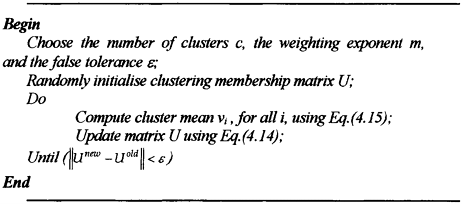64.
| [Cover] [Contents] [Index] |
Page 155
 , for all i, k, a local minimum of Jm may be achieved under the circumstance:
, for all i, k, a local minimum of Jm may be achieved under the circumstance:
 |
(4.14) |
and the ith cluster mean is calculated from:
 |
(4.15) |
The fuzzy c-means clustering is thus performed by iteratively applying Equations (4.14) and (4.15). A complete algorithm is presented in Figure 4.4.
The effect of the exponent is worthy of further consideration. As m → 1, the solution of the fuzzy c-means procedure converges to hardness or crispness (i.e. a pixel’s membership grades become closer to 1 or 0, respectively), while the greater the value of m (e.g. two or more), the fuzzier the membership assignments will be (i.e. the membership grades for all clusters are close to each other). Cannon et al. (1986) suggested that, for any value of m between 1.3 and 1.8, a high performance-oriented segmentation could be obtained. Nikhil and Bezdek (1995) also suggested that the choice of m value in the interval [1.5, 2.5] gives a valid clustering result. Once the clustering process is finished, each pixel can be assigned to the cluster for which the pixel’s membership grade is largest, if one wants to perform a crisp interpretation. Alternatively, one can scale membership

Figure 4.4 The fuzzy c-means clustering algorithm.
| [Cover] [Contents] [Index] |
EAN: 2147483647
Pages: 354